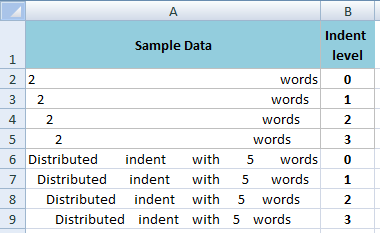
#Indent format in excel code#

Therefore, we will show you various examples of custom format cells in Excel.
#Indent format in excel how to#
Without any special handling, the following characters can be used.ġ7 Examples to Use Custom Format of Cells in ExcelĬustom formatting in Excel is a highly powerful tool, and once you figure out how to use it correctly, your options are nearly limitless. Some characters appear in a numerical format by default, while others require specific treatment. It is used to make use of conditional formatting. It’s typically paired with other space character to adjust alignment.

Specifies the format for indicating scientific notation.īypasses the following character’s width.Ĭontinue with the next character until the cell is entirely filled. The percentage indication is presented after multiplying the values input in a cell by 100. The character that comes after it is shown.Īny text wrapped in double-quotes will be shown. After a digit placeholder, a comma represents the numbers multiplied by a thousand. Unimportant zeros are represented in a digit placeholder.Ī digit placeholder, which leaves a place for them but does not show them, hides unimportant placeholder The following hints will show you how to utilize these format codes in the most usual and practical ways.ĭigit placeholder which does not show extra zeros and symbolizes optional digits. Supposedly, you can create an endless number of custom number formats in Excel by applying the formatting codes mentioned in the table below. For zeros (display dashes instead of zeros).In the case of the negative numbers (enclosed in parenthesis).For Positive numbers (display 3 decimal places and a thousand separator).In this order, it consists of 4 sections of code. To develop a custom format in Microsoft Excel, you must first understand how the number format is recognized by Microsoft Excel. Note: you can open the Format Cells dialog box with the keyboard shortcut Ctrl + 1. To customize the format, go to the Home tab and select Format cell, as shown below. You can utilize the required format type under the custom option. You can change the format of a cell using the Format Cell option. Because Excel interprets date and timeas general numbers, this is essential.

:max_bytes(150000):strip_icc()/GDocs_Indent_09-98dff5725aae484dab1fc1afa011fa15.jpg)
You can change the format of the number inside the cell using the Custom format option. Basic Concept of Custom Formatting of Cells in Excel


 0 kommentar(er)
0 kommentar(er)
